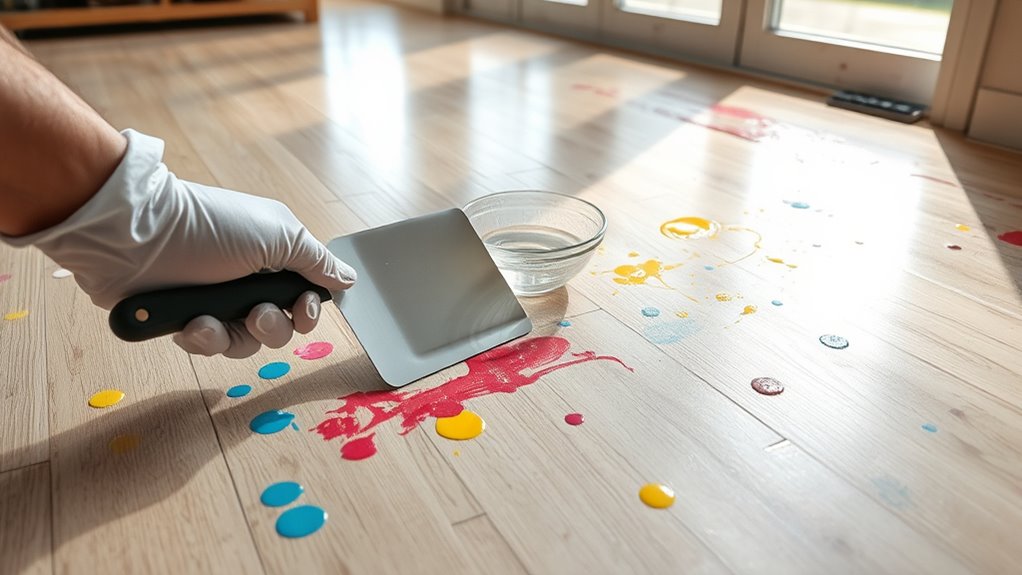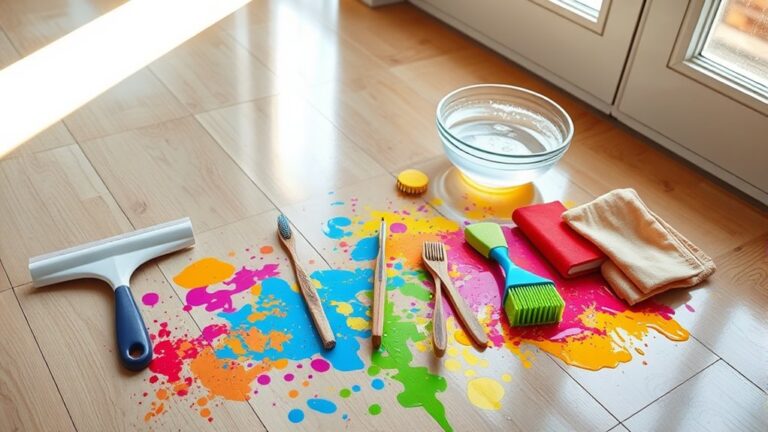To get paint off laminate flooring easily, first identify whether it’s water or oil-based paint. Start with warm, soapy water to gently remove fresh paint. For dried spots, apply rubbing alcohol on a cloth and rub gently—always test in a hidden area first to avoid damage. Use a plastic scraper carefully to lift paint without scratching. Avoid harsh chemicals like acetone or ammonia that can harm laminate. Thoroughly clean and dry the floor afterward. There are more tips to help you clean safely and effectively.
Identify the Type of Paint on Your Laminate Flooring
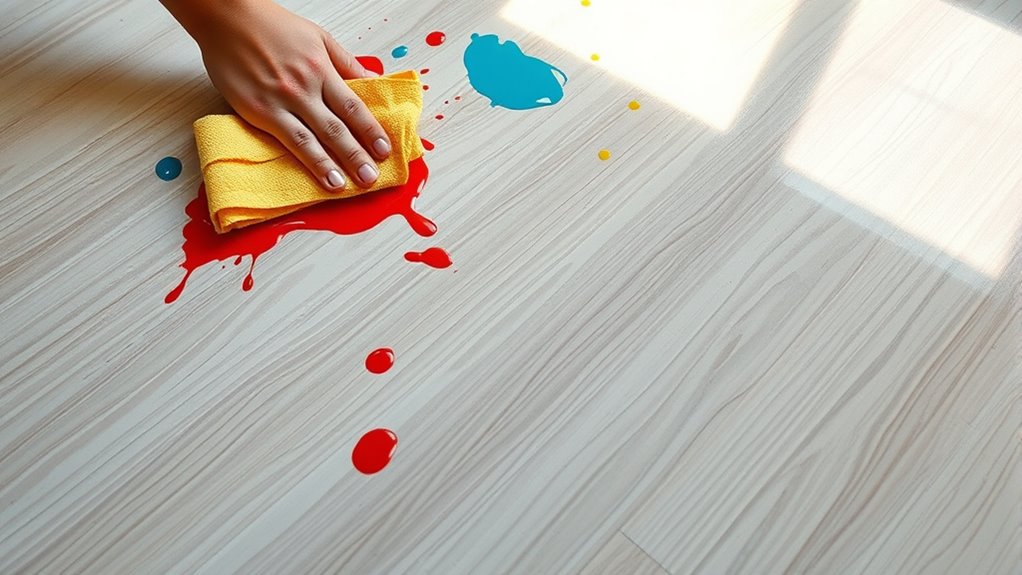
How can you tell what type of paint is on your laminate pavimentazione? First, consider the paint types commonly used: water-based (latex) or oil-based. Water-based paints are easier to clean and often dry with a matte or satin finish, while oil-based paints tend to be glossy and stronger-smelling. Check your flooring types; laminate usually resists water, so if the paint is peeling or cracking, it might be oil-based. You can also test a small hidden spot by applying a bit of rubbing alcohol—if the paint softens, it’s likely water-based. Identifying the paint type helps you choose the right removal method without damaging your flooring. Knowing this frees you to tackle the cleanup effectively, preserving your laminate’s look and durability.
Gather the Necessary Cleaning Supplies
Before you begin removing paint from your laminate flooring, make certain you have the right cleaning supplies on hand. You’ll need a few essentials to protect your flooring and tackle the paint effectively. Start with a soft cloth or sponge for gentle scrubbing, and a plastic scraper to lift dried paint without scratching. Have a bucket of warm water mixed with mild dish soap ready to loosen paint spots. For tougher stains, consider isopropyl alcohol or a commercial laminate-safe paint remover—but remember, choose products specifically labeled for laminate care. Gloves will protect your hands, and paper towels or clean rags help with drying and wiping. Having these cleaning supplies prepared guarantees a smooth, efficient process that safeguards your flooring’s finish and your freedom from stubborn paint stains.
Test Cleaning Solutions on a Small Hidden Area
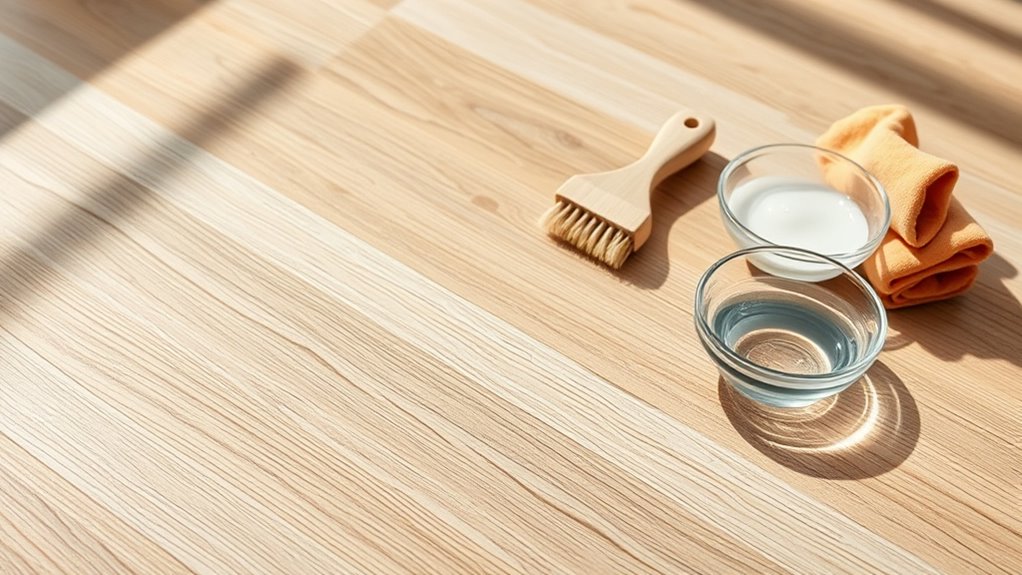
Before you start cleaning, pick a small, hidden spot on your laminate floor to test the solution. Apply just a tiny amount of the cleaner and wait a few minutes to see if it causes any damage or discoloration. This quick check helps you avoid ruining visible areas while removing paint safely.
Choose Inconspicuous Spot
Although you might be keen to remove paint quickly, you should always test cleaning solutions on a small, hidden area of your laminate floor first. Choose a spot that’s inconspicuous—under furniture or along a baseboard—so any unexpected changes won’t be obvious. This lets you check how the solution affects color matching and surface texture without risking visible damage. Laminate floors can vary in finish, so testing guarantees the cleaner won’t dull or discolor the area. If the test spot shows no signs of damage or discoloration after drying, you can confidently proceed with cleaning the paint. Taking this small step protects your floor’s appearance and keeps your freedom intact, avoiding costly mistakes or permanent marks on your laminate surface.
Apply Small Solution Amount
Once you’ve selected your cleaning solution, apply only a small amount to the hidden test spot to avoid oversaturating the laminate. This step is essential in paint removal techniques because it helps you gauge how the laminate will react without risking damage to the visible floor. Use a soft cloth or cotton swab to dab the solution gently, making certain it penetrates just enough to test effectiveness. Applying small amounts also prevents excess moisture, which can warp or discolor laminate flooring. By testing in this controlled way, you maintain your freedom to choose the best laminate cleaning methods without guesswork. Remember, patience here saves you from costly mistakes later and guarantees your floor stays pristine while effectively removing paint.
Observe Reaction Time
Since different cleaning solutions react uniquely with laminate flooring, you’ll want to observe the reaction time carefully after applying your test spot. This step is essential to avoid damage and guarantee effective paint removal techniques. Apply a small amount of your chosen solution to a hidden area, then wait and watch for any discoloration, warping, or residue changes. Laminate floor care requires patience and precision.
| Reaction Time | Possible Outcome |
|---|---|
| 1-5 minutes | No change – safe to proceed |
| 5-10 minutes | Slight discoloration – use cautiously |
| 10-15 minutes | Surface dulling or swelling – avoid use |
| Over 15 minutes | Significant damage – discard solution |
Monitoring reaction times helps you protect your floors while removing paint safely and effectively.
Use Warm Soapy Water for Fresh Paint Spots
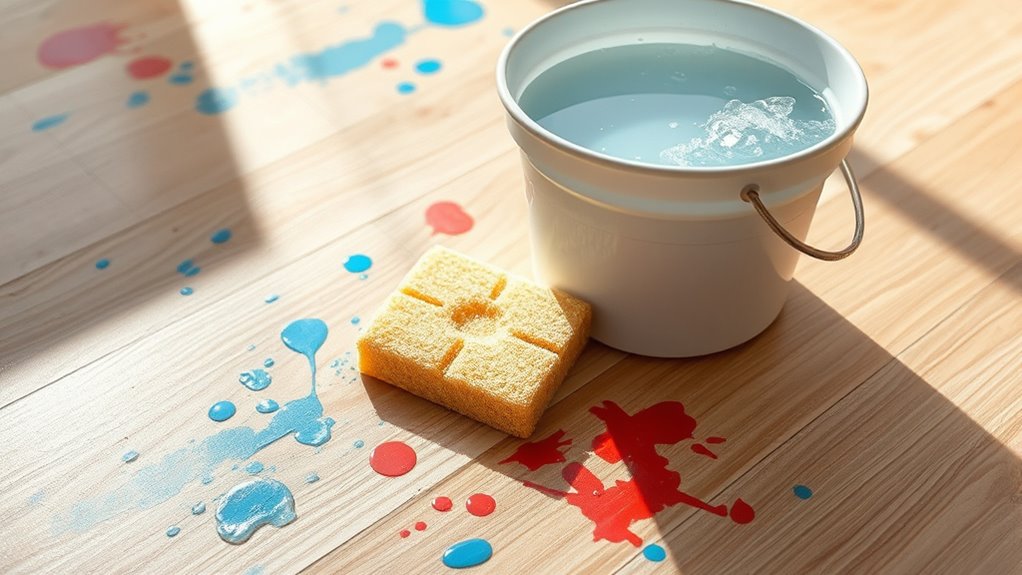
If you catch paint on your laminate flooring before it dries, using warm soapy water can be an effective way to remove it without damaging the surface. This method offers a gentle yet efficient solution that respects your floor’s finish while maximizing cleaning effectiveness. To boost your paint removal techniques, follow these steps:
- Mix warm water with a mild dish soap to create a soapy solution.
- Dip a soft cloth or sponge into the solution and gently blot the paint spot.
- Avoid scrubbing harshly to prevent surface scratches.
- Rinse the area with clean water and dry immediately with a towel.
Acting quickly with this approach lets you maintain your laminate’s look and enjoy a hassle-free cleanup experience.
Apply Rubbing Alcohol to Remove Dried Paint
When warm soapy water doesn’t fully remove dried paint from your laminate flooring, rubbing alcohol can be a reliable next step. Dampen a clean cloth or cotton ball with rubbing alcohol and gently rub the paint stain. The alcohol helps break down the paint without damaging the laminate surface. Work slowly and test a small, hidden area first to guarantee the finish stays intact. After the paint starts to loosen, wipe it away with a clean cloth. For stubborn spots, reapply rubbing alcohol as needed, but avoid soaking the floor to prevent moisture damage. This method offers a practical, effective solution for paint removal, helping you keep your laminate flooring looking fresh and free from unwanted paint marks.
Try Nail Polish Remover for Stubborn Paint Stains
If rubbing alcohol doesn’t do the trick, try using nail polish remover with acetone for those stubborn paint stains. Make sure to choose a remover without added dyes or fragrances to avoid damaging your laminate. Apply it sparingly with a cloth, test in an inconspicuous spot first, and always work in a well-ventilated area to stay safe.
Choosing the Right Remover
Choosing the right remover is essential for safely lifting paint without damaging your laminate flooring. You want a product that’s effective yet gentle, ensuring your floors stay pristine. When exploring removal techniques, consider these product recommendations:
- Nail polish remover with acetone: great for stubborn paint stains but test first.
- Rubbing alcohol: effective for fresh spills and less harsh than acetone.
- Commercial laminate-safe paint removers: designed specifically for your floor type.
- Mild dish soap and warm water: best for light, recent paint marks.
Each option offers a balance of power and safety. Always test removers in an inconspicuous spot to avoid surprises. By choosing wisely, you maintain your floor’s freedom from damage while effectively erasing paint mishaps.
Application Tips and Tricks
Picking the right remover is just the start—you’ll also want to apply it correctly to protect your laminate flooring. When tackling stubborn paint stains, try using nail polish remover as a targeted solution. First, test a small, hidden area to verify it won’t damage the finish. Use a soft cloth with a small amount of remover product and gently dab the paint spot. Avoid rubbing harshly, as this can scratch the surface. For effective application techniques, work slowly and patiently, letting the remover break down the paint before wiping it away. Clean the area afterward with a damp cloth to remove any residue. By combining the right removal products with careful application techniques, you’ll keep your floors paint-free without sacrificing their look or durability.
Safety Precautions to Follow
While nail polish remover can be effective for stubborn paint stains on laminate flooring, you’ll want to follow important safety precautions to protect both yourself and your floor. Before you start, wear appropriate protective gear like gloves and goggles to shield your skin and eyes from harsh chemicals. Confirm the area is well-ventilated to avoid inhaling fumes. Protect surrounding areas by laying down floor coverings to prevent accidental damage. Always test the remover on a small, inconspicuous spot first to check for any adverse reaction on your laminate.
- Use protective gear to avoid skin irritation
- Work in a ventilated space for safety
- Cover nearby floors and furniture with floor coverings
- Conduct a spot test before full application
Taking these steps keeps you safe and preserves your flooring’s finish.
Use a Plastic Scraper to Gently Lift Paint
Start by carefully sliding a plastic scraper under the edge of the paint to lift it without damaging your laminate flooring. Choosing the right scraper type is essential—opt for a plastic one rather than metal to avoid scratches. This method is one of the safest paint removal techniques for laminate surfaces. Work slowly, applying gentle pressure to peel the paint off in thin layers. If the paint resists, don’t force it; instead, try softening it first with warm water or a gentle cleaner. Keep the scraper flat against the floor to prevent gouges. By using a plastic scraper correctly, you maintain your flooring’s integrity while effectively removing paint, giving you the freedom to restore your space without worry.
Avoid Harsh Chemicals That Damage Laminate
You’ll want to steer clear of harsh chemicals like acetone or ammonia since they can damage your laminate’s surface. Laminate flooring is sensitive and can easily discolor or warp when exposed to strong solvents. Instead, opt for safer alternatives like warm soapy water or specialized laminate cleaners to protect your floors while removing paint.
Common Harsh Chemicals
Several common household chemicals can quickly damage your laminate flooring if used to remove paint. Steering clear of these harsh substances helps you maintain your floor’s finish while seeking safer chemical alternatives that balance cleaning efficiency with protection.
Be cautious with:
- Acetone or nail polish remover, which can strip laminate’s protective layer
- Paint thinners and turpentine, both highly abrasive and likely to cause discoloration
- Ammonia-based cleaners, which can dull the surface and weaken seals
- Bleach solutions that may cause staining and surface erosion
Opting for gentle, laminate-safe products guarantees you don’t sacrifice your floor’s integrity. By avoiding these harsh chemicals, you keep your laminate flooring looking great without risking irreversible damage.
Laminate Surface Sensitivity
Because laminate flooring has a delicate surface layer, using harsh chemicals can easily cause damage that’s difficult to repair. Protecting laminate durability means avoiding anything that can strip or dull its finish. You want to keep surface maintenance simple and safe to preserve your floor’s look and lifespan.
| Chemical Type | Effect on Laminate |
|---|---|
| Acetone | Strips finish |
| Ammonia | Causes discoloration |
| Bleach | Weakens surface layer |
| Paint Thinners | Dissolves protective coating |
| Strong Alkalis | Leads to warping |
Stay clear of these to maintain your laminate’s integrity and enjoy freedom from costly repairs.
Safe Alternative Solutions
Harsh chemicals can do more harm than good when removing paint from laminate flooring. Instead, opt for safe, eco friendly options that protect your floor’s finish and your health. Natural solvents offer effective cleaning without the harsh side effects. Here are some alternatives to take into account:
- Use a mixture of warm water and mild dish soap for fresh paint spots.
- Try rubbing alcohol or vinegar on dried paint to gently break it down.
- Baking soda paste can act as a mild abrasive without damaging laminate.
- Apply coconut oil for sticky residues, helping to loosen paint safely.
Clean and Dry the Area Thoroughly After Paint Removal
Once you’ve removed the paint, you’ll want to clean the area thoroughly to eliminate any leftover residue or cleaning agents that could damage your laminate flooring. Start by using a damp cloth with warm, soapy water to wipe the spot gently. This simple cleaning technique helps lift any remaining paint particles and neutralizes chemical traces. Next, rinse the area with a clean, damp cloth to remove soap residue. Finally, dry the floor completely with a soft towel to prevent moisture from seeping into the seams, which can cause warping. These maintenance tips not only preserve your floor’s appearance but also extend its lifespan. Taking these steps guarantees your laminate stays in great condition and ready for your next project without worry.
Prevent Future Paint Spills on Laminate Flooring
To keep your laminate flooring looking its best, you’ll want to take proactive steps to prevent paint spills in the first place. Implementing preventive measures saves you time and frustration later. Start by using protective coverings like drop cloths or plastic sheets whenever you paint. Here are some key tips:
- Lay down sturdy drop cloths or old sheets before starting any painting project.
- Use painter’s tape to secure coverings and protect edges.
- Wear shoes dedicated to painting or go barefoot to avoid tracking paint.
- Store paint cans securely away from high-traffic areas to avoid accidental spills.

